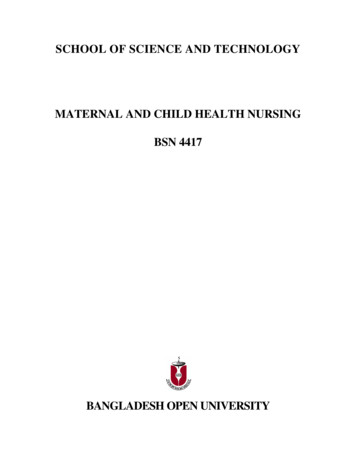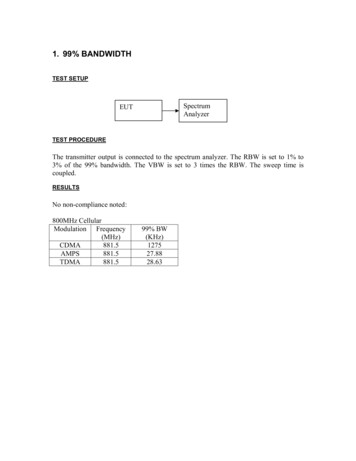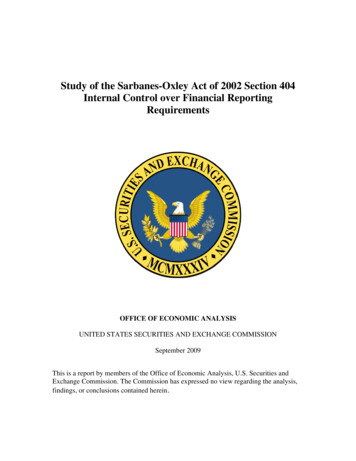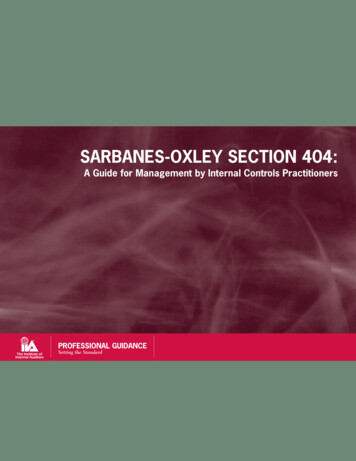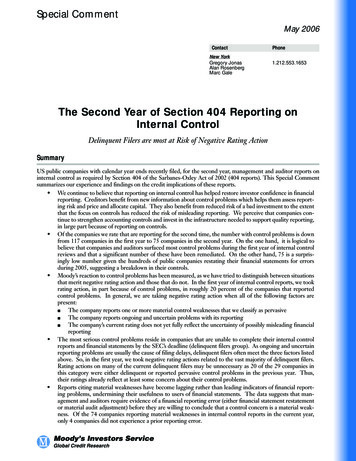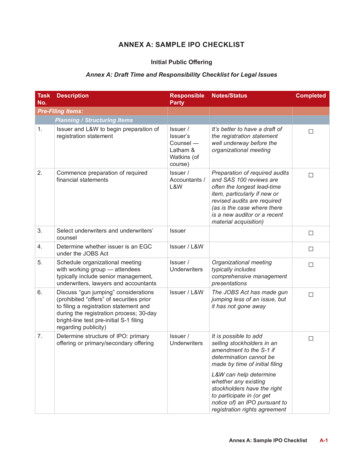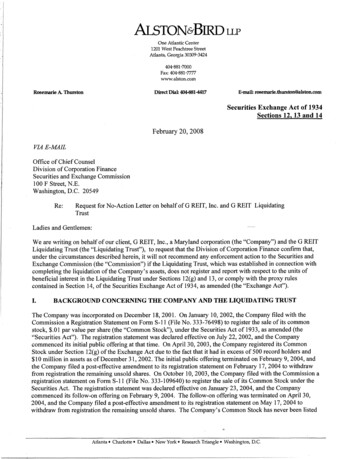
Transcription
One Atlantic Center1201West Peachtree StreetAtlanta, Georgia 30309-3424404-881-7000Fax: 404-881-7777www.alston.comRosemarie A. ThurstonDirect Diak 404-881-4417E-mail: rosemarie.th ton@aIstoncomSecurities Exchange Act of 1934Sections 12,13 and 14February 20,2008VIA E-A44IL1IIkOffice of Chief CounselDivision of Corporation FinanceSecurities and Exchange Commission100 F Street, N.E.Washington, D.C. 20549Re:iIIRequest for No-Action Letter on behalf of G REIT, Inc. and G REIT LiquidatingTrustLadies and Gentlemen:We are writing on behalf of our client, G REIT, Inc., a Maryland corporation (the "Company") and the G REITLiquidating Trust (the "Liquidating Trust"), to request that the Division of Corporation Finance confirm that,under the circumstances described herein, it will not recommend any enforcement action to the Securities andExchange Commission (the "Commission") if the Liquidating Trust, which was established in connection withcompleting the liquidation of the Company's assets, does not register and report with respect to the units ofbeneficial interest in the Liquidating Trust under Sections 12(g) and 13, or comply with the proxy rulescontained in Section 14, of the Securities Exchange Act of 1934, as amended (the "Exchange Act").I.BACKGROUND CONCERNING THE COMPANY AND THE LIQUIDATING TRUSTThe Company was incorporated on December 18,2001. On January 10,2002, the Company filed with theCommission a Registration Statement on Form S-1 1 (File No. 333-76498) to register the sale of its commonstock, .01 par value per share (the "Common Stock"), under the Securities Act of 1933, as amended (the"Securities Act"). The registration statement was declared effective on July 22,2002, and the Companycommenced its initial public offering at that time. On April 30, 2003, the Company registered its CommonStock under Section 12(g) of the Exchange Act due to the fact that it had in excess of 500 record holders and 10 million in assets as of December 31,2002. The initial public offering terminated on February 9,2004, andthe Company filed a post-effective amendment to its registration statement on February 17,2004 to withdrawfrom registration the remaining unsold shares. On October 10, 2003, the Company filed with the Commission aregistration statement on Form S-11 (File No. 333-109640) to register the sale of its Common Stock under theSecurities Act. The registration statement was declared effective on January 23, 2004, and the Companycommenced its follow-on offering on February 9, 2004. The follow-on offering was terminated on April 30,2004, and the Company filed a post-effective amendment to its registration statement on May 17,2004 towithdraw from registration the remaining unsold shares. The Company's Common Stock has never been listedAtlantaCharlotteDallas New YorkResearch Triangle Washington, D.C.
Office of Chief CounselDivision of Corporation FinanceFebruary 20,2008Page 2for trading on any national securities exchange nor quoted on any quotation system, nor has any activesecondary trading market developed for the Common Stock.The Company was formed to acquire, manage, and invest in a diversified portfolio of real estate (or intereststherein) comprised of office, industrial, retail and service properties. The Company completed its first propertyacquisition on September 13,2002, and the Liquidating Trust, as successor to the Company, currently owns aninterest in five real estate investments.The Company operated as a real estate investment trust ("REIT") for federal and state income tax purposes. Tomaintain its REIT status, the Company was required to distribute annually at least 90% of its REIT taxableincome, as defined by the Internal Revenue Code of 1986, as amended (the "Code"), to its stockholders, amongother requirements. If the Company failed to qualify as a REIT in any taxable year, it would be subject tofederal income tax at regular corporate tax rates. As of September 30, 2007, the Company was in compliancewith all relevant REIT requirements.The Company was advised by Triple Net Properties, LLC ("Triple Net Properties" or the "Ad isor"), whichmanaged the Company pursuant to the terms of an advisory agreement, dated July 22,2002, as amended (the"Advisory Agreement"). The Advisor was primarily responsible for managing the Company's day-to-dayoperations and assets, subject to the supervision of the Company's board of directors. The Advisory Agreementexpired on July 22,2005 and was not renewed for another consecutive one-year term. However, the Advisorcontinued to manage the Company on a month-to-month basis pursuant to the terms of the Advisory Agreement.The Advisor engaged affiliated entities to provide various services for the Company's properties.The Company was the sole general partner of G REIT, L.P., the Company's operating partnership (the"Operating Partner hip"). Pursuant to the operating partnership agreement of the Operating Partnership, TripleNet Properties owned an interest as a special limited partner in the Operating Partnership pursuant to which itwas entitled to receive 15% of certain distributions from the Operating Partnership (the "Special Limited PartnerInterest") after the Company's stockholders have received certain returns, as provided by thepartnership agreement. The Operating Partnership did not have any limited partners other than Triple NetProperties.Plan of Liquidation and DissolutionA special committee of the Company's board of directors (the "Special Committee") and the full board ofdirectors of the Company approved a plan of liquidation and dissolution (the "Plan of Liquidation") onDecember 19,2005, respectively, which was thereafter approved by the stockholders of the Company at aspecial meeting held on February 27,2006.The Plan of Liquidation authorized the sale of any and all of the Company's assets without further approval bythe stockholders and provided that liquidating distributions be made to the stockholders as determined by theEffective as of November 16,2006, Triple Net Properties became a wholly owned subsidiary of NNN RealtyAdvisors, Inc. ("NNN Realty Advisors"), a newly formed Delaware corporation. The owners of Triple Net Propertiesexchanged their ownership interests in Triple Net Properties for shares of the common stock of NNN Realty Advisors andcash. On December 7,2007, NNN Realty Advisors became a wholly owned subsidiary of Grubb & Ellis Company, and thestockholders of NNN Realty Advisors exchanged their shares of common stock of NNN Realty Advisors for shares of thecommon stock of Grubb & Ellis Company. However, Triple Net Properties has continued to be the Company's Advisor.The Operating Partnership was never subject to the reporting requirements of the Securities Act or the ExchangeAct.
Office of Chief CounselDivision of Corporation FinanceFebruary 20,2008Page 3board of directors. The Plan of Liquidation further provided that if the Company was not able to sell its assetsand satisfy its liabilities within 24 months of the stockholder approval of the Plan of Liquidation (i.e., February27,2008), the Company could transfer and assign its assets to a liquidating trust without further approval by thestockholders.In accordance with the Plan of Liquidation, all outstanding options were cancelled. The Company adopted aliquidation basis of accounting as of December 3 1,2005 and for all periods subsequent to December 3 1,2005.The Advisor continues to manage the remaining real estate investments held by the Liquidating Trust to controloperating expenses and maximize income. However, due to the adoption of the Plan of Liquidation, theCompany has not acquired and the Liquidating Trust will not acquire any new assets, and is focused onliquidating its remaining real estate investments. Since the stockholders of the Company approved the Plan ofLiquidation, the Company liquidated its position in 20 real estate investments, leaving the Liquidating Trustwith five remaining real estate investments to liquidate.On January 7,2008, the Company's board of directors and the Special Committee authorized the formation ofthe Liquidating Trust and the transfer of assets to the Liquidating Trust. If the assets and liabilities of theCompany were not transferred to a liquidating trust by February 27,2008, the deadline set forth in the Plan ofLiquidation, the Company would not be able to take advantage of the dividends paid federal tax deduction fordistributions made after the Plan of Liquidation was approved. If the Company were not permitted to take thesedeductions, it would become subject to federal income tax on such distributions. A liquidating trust agreementwas executed on January 22,2008 (the "Liquidating Trust Agreement"), and all of the assets of the Companywere transferred to the Liquidating Trust, and all of the liabilities of the Company were assumed by theLiquidating Trust, on January 28,2008.In addition, immediately before the transfer of the Company's assets and liabilities to the Liquidating Trust, theOperating Partnership redeemed the Special Limited Partner Interest held by Triple Net Properties, in exchangefor the right to receive the amount Triple Net Properties would have been entitled to receive under thepartnership agreement for the Operating Partnership if all sales of the properties had been completed prior to theliquidation of the Operating Partnership. After the redemption, the Company held 100% of the outstandingpartnership interests in the Operating Partnership. The Operating Partnership was dissolved on January 28,2008 in connection with the formation of the Liquidating Trust, and all of its assets and liabilities weredistributed to the Company immediately before the transfer of the Company's assets to, and the assumption ofthe Company's liabilities by, the Liquidating Trust.Immediately after the formation of the Liquidating Trust, the Company filed articles of dissolution with theState Department of Assessments and Taxation of Maryland, and the Company's dissolution became effectiveon January 28,2008. Pursuant to Section 3-408 of the Corporations and Associations Code of Maryland, adissolved corporation continues its existence but may not cany on any businesses except that appropriate towind up and liquidate its business and affairs.Current Assets and LiabilitiesAs a result of the ongoing disposition of the Company's real estate assets, the only remaining assets of theCompany transferred to the Liquidating Trust were the following:1.Real Property. The Company owns a 100% interest in an office building in Sacramento, Californiathrough its ownership interest in G REIT Sutter Square, LP, a 100% interest in an office building inDallas, Texas through its ownership interest in G REIT Pacific Place, LP and a 100% interest in anoffice building in Lexington Park, Maryland through its ownership interest in G REIT Pax River
.,I1iOffice of Chief CounselDivision of Corporation FinanceFebruary 20,2008Page 4Office Park, LLC. The Company owns a 78.5% interest in an office building in Fort Worth, Texasthrough its ownership interest in G REIT Western Place, LP. The Company also owns a 30%interest in an office building in Chicago, Illinois through its ownership interest in G REIT CongressCenter, LLC.2.Cash. The Company held approximately 3 1,008,000 in cash for the purpose of satisfying anyunknown, contingent liabilities.3.Restricted Cash. The Company held approximately 1,299,000 in impound reserve accounts forproperty taxes, insurance, capital improvements and tenant improvements.4.Other Assets. The Company held approximately 2,374,000 in net accounts receivable and heldapproximately 369,000 in net accounts receivable from related parties. The Company had alsorecorded 578,000 in receipts in excess of estimated costs associated with the liquidation of theCompany.The following liabilities of the Company were also transferred to the Liquidating Trust:1.Mortgage Loans Payable. The total mortgage debt on the Company's consolidated propertyinterests was approximately 24,000,000 as of December 3 1,2007, and the Company's portion ofthis mortgage debt was approximately 18,840,000 for the same period. The total mortgage debt onthe Company's unconsolidated property interest was approximately 96,10 1,000 as of December3 1, 2007, and the Company's portion of this mortgage debt was approximately 28,830,000 for thesame period.2.Accounts Payable and Accrued Liabilities. Approximately 5,299,000.3.Accounts Payable Due to Related Parties. Approximately 391,000.4.Security Deposits and Prepaid Rent. Approximately 644,000.Except for the liabilities listed above, the Company did not have any known liabilities. However, the Companymade customary representations and warranties in connection with the sale of its commercial real estate assetsregarding the condition of the properties. The Company had no reason to believe any of the representations orwarranties are untrue or would result in any liability on behalf of the Company.Liquidating TrustOn January 22,2008, the Company formed the Liquidating Trust pursuant to the Liquidating Trust Agreementand in accordance with the Plan of Liquidation. On January 28,2008, the Company transferred its thenremaining assets and liabilities to the Trustees (as hereinafter defined) to hold in trust pursuant to theLiquidating Trust Agreement. The purpose of the Liquidating Trust is to wind up the affairs of the Company,liquidate the Company's remaining assets, distribute the proceeds therefrom to the holders of beneficial interestsand pay any liabilities, costs and expenses of the Company or the Liquidating Trust.In accordance with the Plan of Liquidation and the Liquidating Trust Agreement, on anuar-y22,2008 (the"Record Date"), the Company's stock records were closed and each stockholder of the Company on the RecordDate automatically became the holder of one unit of beneficial interest in the Liquidating Trust for each share ofthe Company's Common Stock then held of record by such stockholder. On the Record Date, there were 13,858
Office of Chief CounselDivision of Corporation FinanceFebruary 20,2008Page 5holders of the Company's Common Stock. On January 28,2008, after the transfer of the Company's assetsand liabilities to the Liquidating Trust, all outstanding shares of the Company's Common Stock weredeemed cancelled. Stockholders of the Company on the Record Date were not required to take any action toreceive beneficial interests in the Liquidating Trust. The rights of beneficiaries in the Liquidating Trust are notrepresented by any form of certificate or other instrument. Rather, the Trustees (as hereinafter defined)maintain a record of the name and address of each beneficiary and such beneficiary's aggregate units ofbeneficial interest in the Liquidating Trust. Subject to certain exceptions related to transfer by will, intestatesuccession or operation of law, the beneficial interests in the Liquidating Trust are not transferable, nor does abeneficiary of the Liquidating Trust have authority or power to sell or in any other manner dispose of any suchbeneficial interests. Units of beneficial interest in the Liquidating Trust are not listed on any exchange or quotedon any quotation system.The initial trustees (the "Trustees") of the Liquidating Trust are Gary H. Hunt, W. Brand Inlow, Edward A.Johnson, D. Fleet Wallace and Gary T. Wescornbe, each of who served as a member of the Company's board ofdirectors. Successor trustees may be appointed to administer the Liquidating Trust in accordance with the termsof the Liquidating Trust Agreement. It is expected that from time to time the Liquidating Trust will makedistributions of its assets to beneficiaries, but only to the extent that such assets will not be needed to provide forthe liabilities (including contingent liabilities) assumed by the Liquidating Trust.After the cancellation of the Company's Common Stock on January 28,2008, the Company filed a Form 15with the Commission to terminate the registration of its Common Stock under the Exchange Act and cease filingperiodic reports with respect thereto. The Company filed Form 15 pursuant to Rules 12g-4 and 12h-3promulgated under the Exchange Act. The Company was eligible to rely on these rules because (1) theCompany no longer has any record holders of its Common Stock; (2) the Company had timely filed all reportsrequired by Section 13(a) of the Exchange Act during the three most recently completed fiscal years and throughthe date that the Form 15 was filed;3 and (3) no registration statement relating to the Company's Common Stockbecame effective during 2008, nor was any registration statement previously filed by the Company required tobe updated during 2008 pursuant to Section lO(a)(3) of the Securities Act.Terms of the Liquidating TrustThe terms of the Liquidating Trust Agreement provide that beneficial interests in the Liquidating Trust may notbe transferred; provided that such beneficial interests may be assignable or transferable by will, intestatesuccession or operation of law. The Liquidating Trust Agreement provides that neither the Trustees nor anyaffiliate of the Trustees will take any action to facilitate or encourage any trading in beneficial interests in theLiquidating Trust or in any instrument tied to the value of such beneficial interests such as due bill trading.Anyone affiliated with the Company or the Liquidating Trust will also agree not to take any such action.The Liquidating Trust is organized for the sole purpose of winding up the affairs and liquidating the assets of theCompany and will not continue or engage in the conduct of a trade or business, except as necessary for theorderly liquidation of the assets of the Liquidating Trust. The Trustees are restricted to the holding, collectionand sale of the Liquidating Trust's assets and the payment and distribution of the proceeds thereof in accordancewith the terms of the Liquidating Trust Agreement.The existence of the Liquidating Trust will terminate upon the earliest of (i) the distribution of all suchLiquidating Trust's assets in accordance with the terms of its Liquidating Trust Agreement, or (ii) the expirationSince the filing of the Form 15 by the Company, the Liquidating Trust has timely filed all reports required to be filedthrough the date of this letter.
Office of Chief CounselDivision of Corporation FinanceFebruary 20,2008Page 6of a period of three years from the date assets are first transferred to such Liquidating Trust. The existence ofthe Liquidating Trust may, however, be extended beyond the three-year term if the Trustees then determines thatan extension is reasonably necessary to fulfill the purpose of the Liquidating Trust and, prior to such extension,the Trustees shall have requested and received additional no-action assurances from the Commission.The Trustees are required to issue annual reports to the beneficiaries showing the assets and liabilities of suchLiquidating Trust at the end of each year and the receipts and disbursements of the Trustees with respect to suchLiquidating Trust for each year. The annual reports will also describe the changes in the Liquidating Trust'sassets and liabilities during the reporting period. The financial statements contained in such reports will beprepared in accordance with generally accepted accounting principles; however, it is not contemplated that thefinancial statements will be audited by an independent registered public accounting firm. The annual reportsfurnished to the beneficiaries will be filed with the Commission under cover of Form 10-K using theCommission file number of the Company. Gary T. Wescombe, as Chairman of the Trustees, will sign and file acertification with respect to the annual reports in the form attached hereto as Exhibit A.4 In this regard, theattached certification has been modified from the certification provided in Item 601 of Regulation S-K in thefollowing respects:Signatures: Because the Liquidating Trust does not have a principal executive officer or principalfinancial officer, the signature requirements for the certifications will be met by the Chairman of theTrustees, Gary T. Wescombe, and all references in the certifications are solely to such Chairman.Board and Audit Committee: The Liquidating Trust does not have a board of directors or an auditcommittee and therefore all references to the board of directors and audit committee have been deleted.Statement of Operations: The financial statements of the Liquidating Trust will be provided on aliquidation basis and will therefore not include a statement of operations; all references to the results ofoperations have been deleted and replaced by references to changes in financial condition.Internal Controls: The references in Section 4 of the certification to internal controls over financialreporting and the design of such internal controls will be included in certifications accompanying annualreports at such time as such references would be required to be included by a registrant under theprovisions of Rule 13a-15 under the Exchange Act.The Trustees will cause the Liquidating Trust to file with the Commission current reports under cover of Form8-K using the Commission file number for the Company whenever an event with respect to the LiquidatingTrust occurs that would require the filing of Form 8-K by a company registered under the Exchange Act orwhenever a material event relating to such Liquidating Trust's assets or liabilities has occurred and a copy ofeach such report will be sent to all holders of beneficial interests in the Liquidating Trust. It is not presentlyMr. Wescombe, who formerly served as the Chairman of the Board and the Chairman of the Audit Committee of theCompany, has been charged with day-to-day administration and management of the Liquidating Trust and its assets. Inaddition, he is responsible for maintaining the accounting books and records of the Liquidating Trust. Mr. Wescombe isperforming the functions of the chief executive officer and chief financial officer of the Liquidating Trust in his capacity asChairman of the Trustees. While the Company's Advisor will continue to assist with the management of the LiquidatingTrust's property, the Advisor will play no greater a role in managing the affairs of the Liquidating Trust than it played withthe Company, and the Advisor was not required to sign a Section 302 certification for the Company. Accordingly, Mr.Wescombe is the appropriate person to sign the certification on behalf of the Liquidating Trust pursuant to the interpretiveguidance provided by the staff of the Commission (See Division of Corporation Finance: Sarbanes-Oxley Act of 2002 Frequently Asked Questions, November 8, 2002).
Office of Chief CounselDivision of Corporation FinanceFebruary 20,2008Page 7contemplated that the Liquidating Trust will provide beneficiaries with quarterly reports and, therefore, noquarterly reports will be filed under cover of Form 10-Q for the Liquidating Trust.11.ANALYSISThe Commission or its staff has in the past consistently agreed to grant relief from the Section 13(a) and 15(d)reporting requirements for quarterly reports on Form 10-Q and with respect to the inclusion of audited financialstatements in annual reports on Form 10-K to registrants who have substantially curtailed their operations upona showing that not filing quarterly reports or including audited financial statements in annual reports would notsignificantly alter the total information available to investors and that filing quarterly reports and includingaudited annual financial statements in annual reports would present an unnecessary burden or expense. SeeExchange Act Release No. 9660 (June 30, 1972) (Release 34-9660) and the following no-action letters: ICONCash Flow Partners L.P. Seven and ICON Cash Flow Partners L.P. Seven Liquidating Trust (Pub. Avail.August 14,2007); TREIT Inc. and T REIT Liquidating Trust (Pub. Avail. August 9,2007); Cygnus, Inc. (Pub.Avail. March 27,2006); FORE Holdings, LLC and FORE Holdings Liquidating Trust (Pub. Avail. Dec. 1,2005); Shelbourne Properties et al. (Pub. Avail. Apr. 29,2004); Wilmington Trust Company, as Trustee, andAFG Investment Liquidating Trusts (Pub. Avail. June 18,2003); PLM Equipment Growth Fund 111, LiquidatingTrust (Pub. Avail. June 9,2003); Wilmington Trust Company et al. (Pub. Avail. Feb. 26,2003); and, BurnhamPacific Properties, Inc. and BPP Liquidating Trust (Pub. Avail. June 2 1,2002).The Liquidating Trust will operate exclusively to liquidate its remaining assets, pay its expenses and obligationsand distribute cash to the holders of its beneficial interests. It will not operate in any capacity to acquireadditional investments. Units of beneficial interest in the Liquidating Trust will not be listed on any exchangeand will not be actively traded.It is our opinion that the Liquidating Trust will not be an issuer of "equity securities" within the meaning ofSection 12 of the Exchange Act. The Liquidating Trust will operate solely for the purpose of liquidating anddistributing the cash and the cash proceeds from the liquidation of the assets transferred to it, and will terminateupon the complete distribution of the trust corpus or the expiration of a period of three years from the date theassets were first transferred to it. Except as may be necessary to complete the liquidation of the assets held intrust, the Liquidating Trust will not continue or engage in the conduct of any trade or business. No certificateswill be issued to represent the beneficial interests in the Liquidating Trust and such beneficial interests will notbe transferable. Due to the restriction on transfer, there is no market for the beneficial interests in theLiquidating Trust and, consequently, no need for the general public to have the type of information about theLiquidating Trust required by Section 13 of the Exchange Act or the proxy rules. Nevertheless, beneficiaries ofthe Liquidating Trust will continue to receive periodic reports under cover of Forms 10-K and 8-K. In addition,the chairman of the Trustees will sign and file a certification in his individual capacity with respect to the annualreports in the form attached hereto as Exhibit A. The Commission or its staff has consistently accepted thisposition regarding the registration requirements of liquidating trusts. See, e.g., ICON Cash Flow Partners L.P.Seven and ICON Cash Flow Partners L.P. Seven Liquidating Trust (Pub. Avail. August 14,2007); TREIT, Inc.and T REIT Liquidating Trust (Pub. Avail. August 9,2007); Cygnus, Inc., supra; FORE Holdings, LLC andFORE Holdings Liquidating Trust, supra; Shelbourne Properties et al., supra; Wilmington Trust Company, asTrustee, and AFG Investment Liquidating Trusts, supra; PLMEquipment Growth Fund 111, Liquidating Trust,supra; Wilmington Trust Company et al., supra; and Burnham PaciJic Properties, Inc. and BPP LiquidatingTrust, supra.In addition, compliance with the reporting obligations of the Exchange Act and the proxy rules would place anunreasonable financial and administrative burden on the Liquidating Trust and significantly reduce the amountof distributions to holders of beneficial interests. The cost of auditing annual financial statements and preparingand filing quarterly reports would further decrease the proceeds available for distribution. Further, holders of
Office of Chief CounselDivision of Corporation FinanceFebruary 20,2008Page 8beneficial interests will receive annual statements from the Trustees and will be provided with other annual andcurrent reports as deemed necessary by the Trustees, filed on Form 10-K or 8-K, as appropriate. Annual reportswill contain information for a company in a non-operating, liquidation mode prepared in accordance withgenerally accepted accounting principles. As discussed above, the chairman of the Trustees will sign and file acertification in his individual capacity with respect to the annual reports in the form attached hereto as ExhibitA.Therefore, because (i) there will be no market, public or private, for beneficial interests in the Liquidating Trust,(ii) the Trustees of the Liquidating Trust will keep beneficiaries of the Liquidating Trust informed of pertinentfiscal developments through timely filings of annual reports and current reports under cover of Forms 10-K and8-K, respectively, and (iii) the reporting obligations under the Exchange Act would place an unreasonablefinancial burden on the Liquidating Trust, it is our opinion that no registration of the beneficial interests in theLiquidating Trust is required under the Exchange Act, and that there is no need for the Liquidating Trust to filequarterly reports on Form 10-Q, to include audited financial statements in its annual reports on Form 10-K or tocomply with the proxy rules. Not requiring the Liquidating Trust (i) to file quarterly reports, (ii) to file annualreports that contain audited financial information or (iii) to comply with the proxy rules would not beinconsistent with the protection of investors as the beneficial interests of the Liquidating Trust will not be tradedand holders thereof will be kept informed of material fiscal developments through annual and current reports.As such, the Company believes that the foregoing meets the criteria established in Release 34-9660 (June 30,1972), which set forth the Commission's position that relief from the reporting requirements may be grantedwhere issuers can demonstrate that such relief is consistent with the protection of investors and that it would bedifficult for the reporting company to comply with such requirements.111.CONCLUSION AND REQUEST FOR NO-ACTION RELIEFBased on the foregoing, we respectfully request the Division of Corporation Finance to confirm that it will notrecommend any enforcement action to the Commission if the Liquidating Trust does not register under theExchange Act and complies with the reporting requ
Re: Request for No-Action Letter on behalf of G REIT, Inc. and G REIT Liquidating Trust i I Ladies and Gentlemen: We are writing on behalf of our client, G REIT, Inc., a Maryland corporation (the "Company") and the G REIT Liquidating Trust (the "Liquidating Trust"), to request that the Division of Corporation Finance confirmthat,
